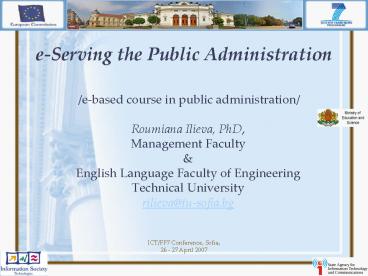eServing the Public Administration - PowerPoint PPT Presentation
1 / 22
Title:
eServing the Public Administration
Description:
'E-BASED UTILITIES FOR SERVING THE PUBLIC-PRIVATE RELATIONS' MODULE ' ... On - line teem work party. Ethical codes of behavior and correctness. ... – PowerPoint PPT presentation
Number of Views:44
Avg rating:3.0/5.0
Title: eServing the Public Administration
1
e-Serving the Public Administration
- /e-based course in public administration/
- Roumiana Ilieva, PhD,
- Management Faculty
- English Language Faculty of Engineering
- Technical University
- rilieva_at_tu-sofia.bg
2
The proposed curriculum is divided into three
main modules
- "TECHNICAL AND NORMATIVE BASE" MODULE
- SECURITY AND DEFENSE MODULE
- "E-BASED UTILITIES FOR SERVING THE PUBLIC-PRIVATE
RELATIONS" MODULE
3
"TECHNICAL AND NORMATIVE BASE" MODULE
- Introduction and a broadcast area of the
e-serving in the public administration - Globalization of the administrative attitudes.
- Necessity of electronic communication in the
society.
4
Communicational characteristics of the electronic
favors.
- Communicational models for public information
exchange. - Technological realization.
- Multimedia meanses for forming, presentation and
granting electronic messages. - On - line teem work party.
- Ethical codes of behavior and correctness.
- Topics of cross-cultural and language differences
and their negotiation.
5
A legislative framework of the e-serving in the
public administration.
- International and national standards and
documents. - The electronic document. The point of the matter.
A mechanism of creation and functioning.
6
SECURITY AND DEFENSE MODULE
- Information safety of document turnover.
- Parameters of the information exchange in the
public administration
7
Main channels for information outflow from the
automated publicly-administrative systems
- Missions of the cryptosystems, main attacks,
vulnerable points and classic threats. - Methods for procuring information safety in the
public administration. - Standards for security estimation.
8
Cryptographic methods of protection
- Different types of algorithms and requirements
for them. - Compound cryptographic systems - advantages.
- Allocation of the keys. Possible scenarios.
- The hierarchy of the keys management.
- Virtual laboratories for cryptographic algorithms
testing.
9
A strategy for security
- Public key infrastructure /PKI/.
- Digital signature.
- Digital certificate.
10
Troubles with the verification, possible
scenarios, causes and solutions
- There are three possible scenarios for getting
an invalid digital signature (fig .1) - 1 scenario A forged digital signature - If the
digital signature is forged the original
hash-value of the message will not be received at
its decoding with the public key, but some other
number. - 2 scenario A forged document - If the document
has been being changed after its signature, the
current hash-value, calculated in the forged
document will be different from the original
hash-value, because the different documents match
different hash-values. - 3 scenario Unconformable public key If the
public key doesnt matche the personal key which
is used for the signing, the original hash-value
got from the digital signature in the decoding
with an inappropriate key will not be true.
11
HashO
HashT
12
Directions for development and automation of the
information security
- Computer cryptography - cryptography with
computers as well as for protection of computers.
- Steganography - Coding and insertion
announcements in unattractive the attention
multimedia pictures and sound with the goal to
conceale the very fact of transmiting information
and using cryptography, namely transfering masked
chifer-texts is effected.
13
"E-BASED UTILITIES FOR SERVING THE PUBLIC-PRIVATE
RELATIONS" MODULE
- Information (electronic) society.
- A broadcast area.
- Main categories
- e-Access
- e-Government and e-Policy.
- e-Health.
- e-Education
- e-Business. e-Trade. e-Pay.
14
e-Bulgaria Index
- Composite indices of
- e-Bulgaria in a progress
- from 2001-2006 year
- e-Society
- e-Access
- e-Education
- e-Business
- e-Governance
- source Arcfund foundation
15
e-Access to information
- Internet content and infrastructure. Usability
and activity. - Access to the telecommunication market.
- Share of the free-of-charge services.
16
The web-site main instrument for e-serving
- Classification.
- Functional characteristics of the web-site.
- Efficiency and consumer's value. Indices and
indicators. - e-Marketing strategies.
- Web-design, branding and promotion.
17
e-Government and e-Policy
- Strategic framework
- Distinctive features.
- Functional models.
- Priorities.
- Integrated information systems for government in
the public administration. - e-Gov training platforms.
18
e-Health
- Sustainable healthcare
- Preventive personalised monitoring and chronic
disease management - Point-of-care diagnostics
- Advanced e-based systems for risk assessment,
prediction and patient safety - Virtual physiology modelling, simulation and
networking - Special attention to risk categories of disabled
people and ageing population.
19
Electronic (distant) education. e-Learning
- E-based cognitive medium.
- Particularities.
- Advantages.
- Electronic contents.
- Virtual libraries.
- Basic prerequisites to the education sites.
- Long-life learning models.
20
e-Business models
- e-Business.
- Classes.
- Models.
- Spheres of act.
- e-Trade.
- Electronic market-places. Types.
- Systems of electronic distribution. Advantages.
- e-Pay.
- Outlines.
- Protocols and certificates for realization.
- Types of cards.
- Virtual availabilities.
21
Modern trends for development of the e-serving
in the public administration
- Transition from electronic to mobile society.
- Electronic mobility.
- e-Services of the future.
22
Bibliography links
- http//www.ipaei.government.bg/eadministration/izi
skvania.pdf - http//www.arcfund.net http//iseca.org/
- http//ec.europa.eu/dgs/information_society/index_
en.htm - http//cordis.europa.eu/fp7/ict/






























